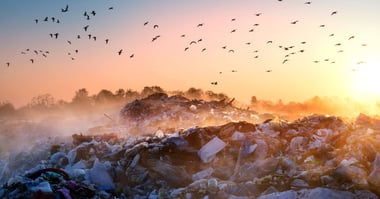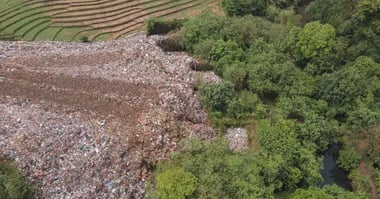In April 2023, stories began to appear about the discovery of a new ecosystem. Unfortunately, the discovery wasn’t made in a rainforest, remote mountain or desert. It was made in the world’s biggest mass of marine plastic.
The Great Pacific Garbage Patch (GPGP) has been making headlines for years, as it accumulates more waste and sets new records. Now, it has grown so large that it now supports an entire ecosystem of invasive species.
Unless we take action soon, scientists have warned that the GPGP will continue to grow “exponentially”. Here’s what you need to know about why it’s there, what it’s doing to the environment, and how we can work towards a solution.
Want to find out how your brand can reduce plastic waste? Check out our guide on Capturing the Conscious Consumer, where you can find the benefits of how to introduce a sustainable strategy, advice on how to do this effectively, and ways CleanHub can help you with the transition.
What's on this page?
- What is the Great Pacific Garbage Patch?
- How do garbage patches impact our planet?
- Can we stop garbage patches from accumulating?
- Summary
What is the Great Pacific Garbage Patch?
There are five so-called “garbage patches” in oceans around the world. Put simply, they are patches of the ocean where marine litter gets collected by swirling currents. That litter doesn’t form one solid island of waste – patches contain (mostly plastic) objects of all sizes, floating across millions of square kilometers.
The GPGP is the largest of the five, having grown to 1.6 million km² – triple the size of France. It’s located in the North Pacific, between Hawaii and California. Data suggests that there are around 1.8 trillion pieces of plastic floating in the patch, from microplastics to what they call “megaplastics” over 50cm.
Why do garbage patches form?
The currents that trap waste are known as gyres. With around 14 million tonnes of plastic reaching the ocean every year, wherever there’s a gyre, there’s a garbage patch.
The North Pacific Gyre spans from the coast of Japan to the USA and back, drawing in waste from both coasts. To reason it’s the largest patch on earth, though, could be found on the countless fishing boats that work its waters.
Well, over two thirds of the fish we catch come from the Pacific Ocean. That activity has consequences: The Ocean Cleanup believes that up to 86% of the material in the GPGP comes from “fishing activities”, including plastic nets, crates and ropes.
How do garbage patches impact our planet?
Unsurprisingly, clouds of microplastics and rafts of discarded waste have a major impact on the ocean’s ecology, our own physical health, and the climate crisis.
Threatening biodiversity
Once caught in the gyre, millions of the fishing nets in the GPGP become known as “ghost nets”. They may not have a human at the other end, but they continue to snare and kill marine life.
Even the life that thrives on plastic waste could present a challenge. It’s too early to know what the impact of the GPGP’s recently discovered ecosystem will be, but the researchers behind the study are wary of the invasive species that have floated on plastic from the coast:
“There’s likely competition for space, [...] food and resources – but they may also be eating each other [...] we have seen evidence of some of the coastal anemones eating open ocean species, so we know there is some predation going on.” – Linsey Haram, Science Fellow at the National Institute of Food and Agriculture
Viral photographs of turtles tangled in plastic and alien ecosystems have made the garbage patch infamous, but they represent a fraction of the threat to biodiversity and global food supplies. In reality, the damage is being done on a far smaller scale.

Weakening the food chain
Most of the plastic that reaches the GPGP is less dense than water, which is why it floats. In doing so, it blocks the sun from phytoplankton, prevents them from photosynthesizing, and reduces their numbers.
94% of the waste in the GPGP is in the “microplastic” category, which is why the water is often described as cloudy or foggy. That microscopic waste also inhibits plankton photosynthesis. The species that rely on plankton as a food source suffer as a result, which carries on up the food chain and diminishes global marine populations.
While the garbage patch is far from any vulnerable human populations, its impact is felt as close as our kitchens. Those same larger fish also ingest that microplastic, leading to bioaccumulation that passes from their bodies – to ours. Once they’re in our bodies, they pass on chemicals that increase the risk of cancer, amongst other diseases.
The plastic pollution feedback loop
Those microplastics present a serious risk to our climate. Put simply, though:
When microplastics prevent plankton from photosynthesizing, they remove less CO2 from our atmosphere. The more CO2, the hotter the planet gets – and the faster the sun breaks down the plastic in our oceans. Those waste objects break down into more microplastics, releasing greenhouse gases as they degrade, and heating the planet further.
It’s become known as the ocean’s “negative feedback loop”, releasing more and more emissions as time goes on. The sheer scale of the GPGP makes it the largest example of this feedback loop on earth. While it’s difficult to quantify exactly the exact number of emissions it releases every year, it is a serious and worsening contributor to global warming.

Can we stop garbage patches from accumulating?
Meeting a challenge of this scale requires action from the ocean itself to the coast, rivers, recycling plants, and government offices. Without a coordinated effort, the patch will continue to grow alongside our increasing plastic production, and the negative feedback loop will speed global warming further.
Removing plastic from the Great Pacific Garbage Patch
Organizations like The Ocean Cleanup have been undertaking litter-picks on a massive scale, removing floating plastic directly from the GPGP and other global garbage patches. Using a large U-shaped barrier pulled by two ships, they are able to cover a huge amount of ground. Their first effort, which began in 2021, has already recovered over 200,000kg of plastic.
It’s a crucial effort in the mission to curb the patch’s growth, and to prevent large plastic objects from creating more microplastics in the future.
The organisation plans to recycle as much of the plastic they recover as possible, using the proceeds from recyclate products to fund further recovery.
Thanks to the incredibly complex mix of plastics, it’s impossible to gather a heterogeneous material stream from the ocean. The use-cases for the recyclates can be limited, but brands and packaging producers can make the effort to adapt their designs to mixed plastic materials. Companies like Adidas have offered early examples of this adaptation in action, designing shoes made from composite ocean plastics.
The Ocean Cleanup faces a losing battle until we make changes on land. Their work remains admirable and necessary, but a garbage truck’s worth of plastic is dumped into the world’s oceans every minute. In short, the GPGP grows far faster than they can shrink it. For their work to make a real impact, we need to stem the flow of material into the ocean.
Cutting coastal pollution
In order for the work of organizations like The Ocean Cleanup to be effective, more waste needs to be captured before it can make its way into the water.
As many as 2 billion people in coastal regions around the world can’t effectively process waste. It’s one of the biggest reasons that so much plastic ends up in the ocean in the first place – and presents a serious health risk to vulnerable populations before it even gets there. It’s a major social wellbeing challenge for informal waste pickers on the frontline of the plastic crisis.
By investing in coastal waste infrastructure and employment, it’s possible to increase the impact of ocean cleanups directly from the shoreline. The coordinated effort ensures that when boats remove material from the GPGP, it doesn’t get replaced.
Preventing plastic waste
Of course, plastic shouldn’t be dumped on beaches and open coastal landfills in the first place. Global recycling rates remain incredibly low, stalling below 10% over the last few years alongside an increase in plastic pollution. There’s plenty of room for improvement. With stronger regulation (like the UN’s Global Plastics Treaty and increasingly-popular plastics taxes), it’s possible to inch closer to circularity.
By reducing our reliance on virgin plastic and putting a premium on recyclates, everyone from the waste sector to brands and packaging producers will have a clear incentive to invest in recovery infrastructure and recyclable packaging design.
Summary
When the Great Pacific Garbage Patch was discovered in 1997, the world produced around 180 million tonnes of plastic a year. That number has more than doubled since then, and the patch has grown with it.
To halt that growth – and its negative environmental impact – we’ll need to stop providing it with material.
Cutting unnecessary production and supporting coastal recovery on land will ensure the cleanups at sea aren’t in vain.
Want to find out how your brand can reduce plastic waste? Check out our guide on Capturing the Conscious Consumer, where you can find the benefits of how to introduce a sustainable strategy, advice on how to do this effectively, and ways CleanHub can help you with the transition.


-3.png)

.webp?width=380&name=Colourful%20corals%20(1).webp)

%20(1).webp?width=380&name=Plastic-on-the-beach%20(2)%20(1).webp)
%20(1).webp?width=380&name=Pile-of-plastic%20(1)%20(1).webp)
.webp?width=380&name=Plastic-pollution-surface-of-water%20(1).webp)
.webp?width=380&name=solar-collection%20(1).webp)

.webp?width=380&name=River%20waste%20(1).webp)
.jpg?width=380&name=Microplastics%20in%20hands%20(1).jpg)
.webp?width=380&name=recycling%20(1).webp)
